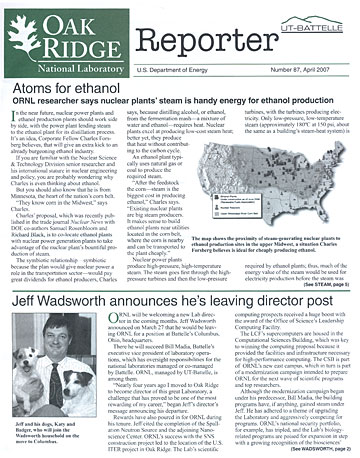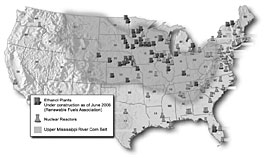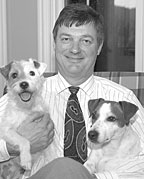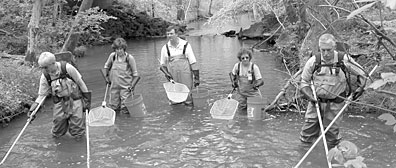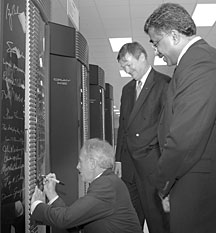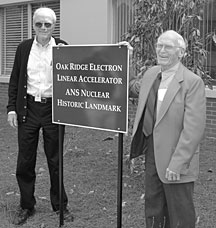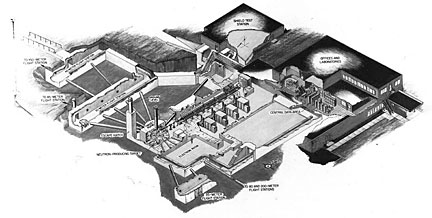 |
Number 87, April 2007 |
 Atoms for ethanol
Atoms for ethanol
ORNL researcher says nuclear plants’ steam is handy energy for ethanol production
|
|
The map shows the proximity of steam-generating nuclear plants to ethanol production sites in the upper Midwest, a situation Charles Forsberg believes is ideal for cheaply producing ethanol. |
In the near future, nuclear power plants and
ethanol production plants should work side by side, with the power plant lending steam to the ethanol plant for its distillation process. It’s an idea, Corporate Fellow Charles Forsberg believes, that will give an extra kick to an already burgeoning ethanol industry.
If you are familiar with the Nuclear Science & Technology Division senior researcher and his international stature in nuclear engineering and policy, you are probably wondering why Charles is even thinking about ethanol.
But you should also know that he is from Minnesota, the heart of the nation’s corn belt.
“They know corn in the Midwest,” says Charles.
Charles’ proposal, which was recently published in the trade journal Nuclear News with DOE co-authors Samuel Rosenbloom and Richard Black, is to co-locate ethanol plants with nuclear power generation plants to take advantage of the nuclear plant’s bountiful production of steam.
The symbiotic relationship—symbiotic because the plan would give nuclear power a role in the transportation sector—would pay great dividends for ethanol producers, Charles says, because distilling alcohol, or ethanol, from the fermentation mash—a mixture of water and ethanol—requires heat. Nuclear plants excel at producing low-cost steam heat; better yet, they produce that heat without contributing to the carbon cycle.
An ethanol plant typically uses natural gas or coal to produce the required steam.
“After the feedstock—the corn—steam is the biggest cost in producing ethanol,” Charles says. “Existing nuclear plants are big steam producers. It makes sense to build ethanol plants near utilities located in the corn belt, where the corn is nearby and can be transported to the plant cheaply.”
Nuclear power plants produce high-pressure, high-temperature steam. The steam goes first through the high-pressure turbines and then the low-pressure turbines, with the turbines producing electricity. Only low-pressure, low-temperature steam (approximately 180ºC at 150 psi, about the same as a building’s steam-heat system) is required by ethanol plants; thus, much of the energy value of the steam would be used for electricity production before the steam was sent to the ethanol plant.
“This low-temperature steam is of lower value for electricity production, but it could significantly improve ethanol economics, create an expanded market for nuclear energy, reduce greenhouse gas emissions, and reduce foreign oil imports,” says the Nuclear News article.
|
|
Forsberg |
President Bush has called for standards requiring 35 billion gallons of renewable fuel production by 2017. Charles says if ethanol is used to meet that goal, it will require almost
30 gigawatts of low-
temperature steam. A readily available source of that steam, obtained without burning fossil fuels, is an already existing nuclear plant in the corn belt.
Only a few years ago ethanol was a niche fuel without much demand. Beyond the desire to reduce oil imports, which is frequently dampened by oil price drops, recent events have created a new market for ethanol.
Reason one, Charles says, is a “biotech revolution.” Turning corn into alcohol is a slow process involving enzymes that break corn down to sugar and then alcohol. It takes time, as any brewer will attest. People have been trying to speed up the process for centuries, and although Charles cites individuals—Jack Daniels, for instance—who became very accomplished at the distillation process, it always has been slow going.
“About 10 years ago an enzyme was developed that could break down corn into sugar and thus make alcohol very quickly simply by adding it to the mash. Suddenly, a small facility could make lots of ethanol,” Charles says.
Secondly, Congress enacted tax incentives for ethanol production. “Always helpful,” Charles observes.
Finally is the MTBE issue. Methyl tert-butyl ether is used as an additive in unleaded gasoline to boost octane. MTBE was developed as a replacement for lead, a toxic metal that crept into the environment as a result of gasoline combustion. Regulators banned lead from gasoline.
However, MTBE itself has turned up in groundwater, provoking environmental concerns. California outlawed its use and MTBE’s days nationally as an additive are numbered. Ethanol, which also is an octane booster, is a promising and environmentally benign replacement.
“We can do ethanol today. The market has appeared,” Charles says.
His proposal doesn’t stop at mere ethanol production. In a second phase of the plan, which could be realized in several decades, nuclear-produced hydrogen could be added to biomass to produce liquid fuels such as gasoline and diesel, increasing the energy value of the fuel per unit of biomass by a factor of three or four. This would enable the U.S. to produce all of its liquid fuels from biomass.
Ultimately, hydrogen itself, produced by nuclear plants, would become the dominant fuel, once the storage and transport challenges are solved and the infrastructure is established. This is the touted hydrogen economy.
“The two real problems we have are dependence on foreign fuel and climate change,” Charles says. “There is a nuclear-biomass option, but first one must learn to crawl—ethanol—then walk—hydrogen and biomass for liquid fuels—and then run—hydrogen as the fuel.”
In the meantime, Charles sees using the available low-temperature steam from existing nuclear power plants to encourage an already accelerating ethanol market as a simple step in the right direction. The payback is a cheaper and mostly carbon-neutral energy source that offers an alternative to imported oil.
Increased ethanol production holds an added advantage for the farmer: More milk from contented cows.
In the ethanol process, the enzyme converts the sugars in the corn kernel’s starchy cotyledon into alcohol. The embryo, on the other hand, remains in a protein-rich mash. These leftovers are an ideal livestock feed.
“For some reason, dairy cattle love the stuff,” Charles says.—B.C. ![]()
 Jeff Wadsworth announces he’s leaving director post
Jeff Wadsworth announces he’s leaving director post
|
|
Jeff and his dogs, Katy and Badger, who will join the Wadsworth household on the move to Columbus. |
ORNL will be welcoming a new Lab director in the coming months. Jeff Wadsworth announced on March 27 that he would be leaving ORNL for a position at Battelle’s Columbus, Ohio, headquarters.
There he will succeed Bill Madia, Battelle’s executive vice president of laboratory operations, which has oversight responsibilities for the national laboratories managed or co-managed by Battelle. ORNL, managed by UT-Battelle, is among them.
“Nearly four years ago I moved to Oak Ridge to become director of this great Laboratory, a challenge that has proved to be one of the most rewarding of my career,” began Jeff’s director’s message announcing his departure.
Rewards have also poured in for ORNL during his tenure. Jeff cited the completion of the Spallation Neutron Source and the adjoining Nanoscience Center. ORNL’s success with the SNS construction project led to the location of the U.S. ITER project in Oak Ridge.
The Lab’s scientific computing prospects received a huge boost with the award of the Office of Science’s Leadership Computing Facility.
The LCF’s supercomputers are housed in the Computational Sciences Building, which was key to winning the computing proposal because it provided the facilities and infrastructure necessary for high-performance computing. The CSB is part of ORNL’s new east campus, which in turn is part of a modernization campaign intended to prepare ORNL for the next wave of scientific programs and top researchers.
|
|
As Lab director, Jeff Wadsworth (center) conducted a series of visits, or walkarounds, to various labs and work areas. In this case it was a wadearound, as he joined a crew sampling wildlife in Bear Creek. |
Although the modernization campaign began under his predecessor, Bill Madia, the building programs have, if anything, gained steam under Jeff. He has adhered to a theme of upgrading the Laboratory and aggressively competing for programs. ORNL’s national security portfolio, for example, has tripled, and the Lab’s biology-related programs are poised for expansion in step with a growing recognition of the biosciences’ role in addressing the nation’s energy challenges.
After his introduction to Lab staff members in late June 2003 (his first official day was August 1, 2003), Jeff quickly established a rapport with the Lab staff and with the Oak Ridge community. Two examples: He instituted the director’s messages—e-mails of Lab news and events from his perspective—that are popular with staff members. In the community, UT-Battelle’s leadership in the drive to renovate Oak Ridge High School has received unanimous support.
“The years seem to have literally flown by since I arrived.” |
|---|
The University of Tennessee and Battelle will immediately begin a search for a new Lab director. ORNL’s previous director search lasted two months, with Madia’s farewell on April 28, 2003, and Jeff’s selection announcement and initial visit to Big Ed’s Pizza on June 30.
With the Columbus job’s responsibility for the Battelle-affiliated labs, Jeff will retain links with ORNL. His announcement indicated that his East Tennessee experience has been overwhelmingly positive, particularly with regard to the Lab.
“Perhaps because the time spent here was so enjoyable, the years seem to have literally flown by since I arrived in August 2003. Very quickly I came to understand that there is something special about working at this marvelous facility. I was struck each day by the depth of talent among our staff and by the genuine excitement with which scientific and operational challenges were approached—challenges, incidentally, that many other institutions find intimidating,” Jeff said in his announcement.
“In a host of ways, these accomplishments have created a lasting foundation for the Lab’s continued growth and vitality,” he
said.—B.C. ![]()
 ORNL recognizes top small business subcontractors; UT-Battelle wins SBA award
ORNL recognizes top small business subcontractors; UT-Battelle wins SBA award
ORNL’s Asset Management and Small
Business Programs Division handed out its annual Small Business Subcontract Awards on March 7 at a Conference Center breakfast.
Nearly half of the Lab’s $1 billion budget goes out through subcontracts, with much of the money going to East Tennessee businesses, Deputy Director for Operations Jeff Smith noted. Chief Financial Officer Greg Turner also pointed out the Lab’s impact on the local economy, especially in work with small businesses who make up the overwhelming majority of businesses in the nation and in the state.
ORNL staff members who were recognized included Small Business Program Advocate: Kathey Carney, Linda Horton and Jackie Smith; HBCU: Harvey Gray and Glenn Jennings; and Organizational Small Business Advocate Awards: (R&D) Ian Anderson and (Operations) Lanny Bates.
Firms receiving small business subcontract awards were, Small Business: International Armoring Corporation; Small Disadvantaged Business: Solutions to Environmental Problems, Inc.; Woman-Owned Business: Peak Beam Systems, Inc.; HUBZone Small Business: PTG Organizational Solutions, LLC; Service Disabled Veteran-Owned Small Business: Advanced Resource Technologies, Inc.; and Veteran-Owned Small Business: Cherokee Steel Supply. ![]()
 ORNL accepted into EPA’s Performance Track program
ORNL accepted into EPA’s Performance Track program
ORNL’s work with its environmental management systems has resulted in a placement on the Environmental Protection Agency’s “A” list. The Lab was recently accepted into the EPA’s National Performance Track program.
The program, which is reserved for facilities with outstanding environmental compliance records and mature environmental management systems, offers potential regulatory incentives including extended waste storage and fewer regulatory inspections. ORNL is only the seventh Tennessee facility to be accepted into the program.
“Similar to our ISO 14001:2004 EMS registration, Performance Track membership recognizes ORNL’s dedication and commitment to environmental leadership,” says the Environmental Protection and Waste Services Division’s David Skipper. “The Performance Track program is a partnership with federal and state regulators that will provide us with the opportunity to realize significant cost savings and efficiency improvements.”
EPWSD staff members will be working with EPA and the Tennessee Department of Environment and Conservation to determine how these regulatory incentives can best benefit ORNL.![]()
 |
 Mementos recall OR past
Mementos recall OR past
The old postcards show ORNL in its earlier days, just after its post-war building boom in the early 1950s. But they are probably more interesting for what they don’t show.
You see in one, for instance, Building 4500-North, minus its easternmost wing, and a muddy spot where 4500-South should be. And not much to the east.
Greg Bell, an Information Technology Services Division technican who works at the Spallation Neutron Source, has collected postcards of Oak Ridge, which include stylized aerial portrayals of ORNL, Y-12 and K-25. Although it’s difficult to fathom why anyone would send someone a postcard of a federal research facility, a market was apparently there.
|
|
Greg Bell’s collection includes the 1955 Oak Ridge phone book, a thin but revealing relic of the city a half century ago. |
The old postcards also reveal that, despite the secrecy of the time, Oak Ridge had a surprisingly public face.
Greg’s postcard collection also has some vanished Oak Ridge landmarks, such as the Skyway drive-in and the original Museum of Atomic Energy, plus a set that features the various models of government housing, A through F, found in the town.
The Bell family moved to Oak Ridge in 1954, when Greg was three, so some of the images bring back fond memories. He also has several of the “irradiated” dimes from the museum, including a mercury dime with ORNL printed on its metal case.
“It’s an interesting hobby, but I think it’s also preserving some of the history of a very unique place,” Greg says.
 Energy on the agenda
Energy on the agenda
|
|
Sen. Bob Corker adds his name to the, by now, long list of VIPs who have signed ORNL’s supercomputer, with hosts Jeff Wadsworth (center) and Thomas Zacharia. |
Bob Corker made his first visit to ORNL as Tennessee’s junior senator on April 2, touring the Lab and signing ORNL’s ceremonial supercomputer in the Leadership Computing Facility.
The former mayor of Chattanooga noted that city’s interest in the Laboratory and indicated that the nation’s capital also has an eye on Oak Ridge.
“People in the Oak Ridge area tend to take for granted what is here,” he said. “But in Washington, ORNL is a highly regarded laboratory, and people are looking to ORNL, as well as UT and TVA.
Sen. Corker sees energy security as one of the top issues for the Senate’s energy committee, of which he is a member.
“Regardless of how many feel about the science, the country needs to be energy secure. We have a goal to be energy secure, not so much in response to a crisis, but to embrace the technologies,” he said.
Corker is also on the Foreign Relations Committee, which he says often deals with issues “very much tied to energy.”
 Venturing nanotech in the marketplace
Venturing nanotech in the marketplace
The worlds of marketing and venture capital are normally alien to researchers who are nevertheless working on potentially valuable innovations. Putting science and the marketplace together was the theme of Nano Nexus, held at ORNL April 2-4.
Organized by Tech 2020, the conference mixed venture capitalists, researchers and university students toward the ins and outs of obtaining the necessary backing and investment to make a good idea sail in the marketplace.
The three-day conference included an “Idea to Product” competition among 11 universities that took a technology from bench to marketing plan. The winner in a field of 15 entries dominated by medical and fuel cell technologies was a University of Texas team’s NANOTaxi, a drug delivery system.
A panel of representatives from venture capital companies emphasized to the attendees the importance of doing research on potential investors before approaching them and of establishing relationships with investors once you have met them.
“Venture capitalists see a lot of ideas. They listen to the people they know and trust,” says Keith Gillard of BASF Venture Capital.
Otherwise, John Chen of Battery Ventures set the parameters on how to approach a venture capitalist.
“Anytime, anyplace, anywhere.”
 Coyote prowls Lab
Coyote prowls Lab
Last summer a couple of fawns took up residence on a grassy lawn in the center of the ORNL campus. Groundhogs, skunks and raccoons are established residents of the Lab. This might be the year of the coyote.
One of the shy and rarely seen critters was spotted by several people one afternoon in March near Building 4500-South.
“The coyote is a very adaptable animal and is seen around the fringes of developed areas,” says ORNL wildlife management coordinator Neil Giffen.
“We have on occasion heard some yippin’, yappin’ and howlin’ on nights we have been out in certain areas of the reservation. I think they definitely like it here,” Neil says.
His advice is the same as for the ORR’s other wild critters: Leave them alone and don’t feed them or leave out food for them. They are wild animals and they need to stay that way.
Maybe that particular coyote was after a Bethel Valley Road-runner.
—Reported by Bill Cabage |
 Not quite history
Not quite history
ORELA is a ‘historic landmark,’ but will still crank out needed data
|
|
Former ORELA directors Fred Maienschein (left) and Jack Harvey flank the new sign with the nuclear historic landmark designation. |
Current and former ORNL employees convened in ORNL’s Conference Center on March 26 to mark the designation by the American Nuclear Society of the Oak Ridge Electron Linear Accelerator as a nuclear historic landmark.
The designation is somewhat ironic. It’s true that ORELA has put in three solid decades of providing measurements on the behavior of elements when exposed to neutrons, which is critical information for nuclear reactor and fuel element designers, astrophysicsts and a plethora of other scientific disciplines.
But far from becoming a relic, the neutron source is seeing a new life with the National Nuclear Security Administration, which is looking to ORELA to generate information for its nuclear criticality safety and national security-related programs.
ORELA was commissioned in 1969 to provide badly needed data for fusion blanket materials studies and for the eventually truncated breeder reactor project. Over the years, the subterranean facility built up a data base of 180 isotopes, providing neutron cross-section data to the scientific community.
The cross-section measurements provide the probability that a reaction will occur in an element exposed to a neutron and also what kind of reaction: whether the neutron is captured, fissions or scatters. ORELA excelled at these measurements.
“You knew when you gave a talk that nobody would have data comparable to yours,” said former ORELA Director Duane Larson, who is also heading up the ORELA Heritage Project.
The work is extremely math intensive: Radiation transport modeling and simulation have driven advances in scientific computing. The Nuclear S&T Division’s Nancy Larson developed the SAMMY R-matrix analysis software, still in use around the world and still being improved as a sophisticated computational tool for determining probability distributions.
In 1990 ORELA produced the first meaningful values of the polarizability of neutrons, the result of experiments that involved “very elusive” measurements. Follow-up experiments with more advanced detectors have recently confirmed the values.
“We got it right,” Larson said.
Right enough that more than three fourths of the data in the U.S. Evaluated Nuclear Data File at Brookhaven Lab comes from ORELA measurements.
ORELA over the years has been a training ground for scientists and for scientists who have become administrators. Jack Gibbons, who headed the Office of Science and Technology Policy in the 1990s, did astrophysics research there. Former ORNL Director Bill Madia did graduate research with positrons at ORELA and often dropped in to see positron researcher Les Hulett during his days here.
With a new mission and recent refurbishment, ORELA is being referred to as ORNL’s third neutron source, along with the Spallation Neutron Source and the High Flux Isotope Reactor. Like the SNS, ORELA is a pulsed neutron source.
In another irony, ORELA’s linac cost, in late 1960s dollars, was $1.4 million. The SNS construction cost, three decades later, came in exactly three decimal places to the right at $1.4 billion.
The SNS, of course, is a much more powerful machine. ORELA will continue to serve its niche, producing neutrons at energy ranges that are important to a number of applications and ideal for generating safety criticality and cross-section data.
|
|
One of ORELA’s advantages as a neutron source is that much of it is underground. The facility is being referred to as ORNL’s third neutron source, joining the Spallation Neutron Source and the High Flux Isotope Reactor. |
More isotopes remain to be studied, particularly those of interest to a re-emerging nuclear industry, such as the less famous uranium-234 and U-236 isotopes.
Then again, they might find the data in Jack Harvey’s basement. Harvey, who directed ORELA in its heyday with Fred Maienschein, has kept troves of publications and data, including the first proposals to build the facility in the early 1960s.
“I enjoy seeing things work, and I enjoyed seeing the data come out. ORELA had more intensity and better resolution than anything,” Jack says.
He has enjoyed the data so much that he has been loathe to dispose of any of it.
“Our basement is full of files and boxes,” says Mary Harvey, Jack’s wife. “If we kept everything he wanted to keep we’d have to build another house,” she says, just slightly rolling her eyes.—B.C. ![]()
|
|---|
The Global Nuclear Energy Partnership is a much-discussed topic, both nationally and locally, among those who tout nuclear power as one answer to two problems associated with fossil fuels: dwindling supply and carbon-induced climate change. |
 |
At left, a kingfisher gobbles down a goldfish. Below, a bluebird looks up at a fledgling. |
|
|---|---|---|
Steven Pain’s Building 6025 office is ideally situated for his hobby. The Rutgers University postdoc and amateur nature photographer has had a field day photographing wildlife around the nearby Conference Center pond. He shoots with a Canon digital camera with a 400-mm telephoto lense—and a lot of patience and luck. Here are some examples from a CD full of photos. |
||
 |
|
|
 ORNL People
ORNL People
UT-Battelle has received this year’s Small Business Administration Frances Perkins Vanguard Award, which recognizes excellence in the use of women-owned small businesses as prime contractors and subcontractors, based on leadership, advocacy, innovation and implementation.
“This award is particularly noteworthy because it is for our achievements with women-owned small businesses. With the help of the Contracts Division and Small Business management team and our management, we just completed a clean sweep of all the SBA national awards,” says the Asset Management and Small Business Programs Division’s Will Minter.
Elissa Chesler, leader of the Mouse Systems Genetics group in the Biosciences Division, has been selected to receive the International Behavioural and Neural Genetics Society’s (IBANGS) annual Young Scientist Award. Elissa has been invited to speak at the IBANGS meeting in Doorwerth, The Netherlands, this spring.
Fusion Energy Division Director Stan Milora has been approved as a U.S. representative to the ITER Science and Technology Advisory Committee. The committee will advise the international ITER organization on critical and urgent issues related to science and technology of the ITER. Stan is also the director of the U.S. Virtual Laboratory for Technology and chief technologist of the U.S. ITER Project.
Ken Bowra of the National Security Directorate was recently recognized by the National Defense Industrial Association, “for a lifetime of conspicuous achievement to the Special Operations community of the U.S. military.” Ken’s long service was highlighted “as having significantly enhanced our Nation’s military capability.”
A team from the Materials S&T Division’s Ceramic Science and Technology Group won the first-place poster award at the 31st International Cocoa Beach Conference on Advanced Ceramics and Composites in Daytona Beach, Fla., for their poster titled, “C-Sphere Flexure Strength of Three Bearing-Grade Silicon Nitrides.” Tim Kirkland and Andy Wereszczak were joined by the University of Wisconsin’s Osama Jadaan and Georgia Tech student David Ryan, a Higher Education Research Experiences program student from last summer.
An image from work by Radu Custelcean and Bruce Moyer of the Chemical Sciences Division is featured on the cover of the European Journal of Inorganic Chemistry. The cover picture shows selective anion separation using metal-organic frameworks. Sokwon Paik, a CSD post-doc working with James Lee of the Chemical Sciences Division, is the author of a paper featured on the cover of Langmuir.
Two members of the Farragut High School team that won this year’s Tennessee Science Bowl are veterans of ORNL student projects. Zhong Zhang’s mentor is Rick Riedel in the Neutron Scattering Science Division. Eddie Buehler’s mentor is Malcolm Stocks in the Materials S&T Division. The two, along with eight other Farragut students, have been participants in the Higher Education Research Experiences program, administered at ORNL by the Oak Ridge Institute for Science and Education.
 In a dry season, forester urges, be careful with fire
In a dry season, forester urges, be careful with fire
With dry conditions, accumulated fuels, high winds and “urban interfaces,” East Tennessee has had several woods fires that have resulted in property damage this spring. The Oak Ridge Reservation is not immune to wildfires, says ORR forester Greg Byrd.
Greg says that the most common causes of wildfires on the ORR are careless burning and smokers.
“In fact, 90 percent of all wild fires are caused by people,” Greg says.
This spring’s dry weather resulted in woods fires near developments in Sevier County, which destroyed several dwellings.
Tennessee typically has a spring and fall fire season. The spring fire season, prompted by warming weather, begins about February 15 and ends near May 15, when the forest has usually “greened up” enough to prevent the rapid spread of forest fires.
The fall fire season begins around October 15, when the leaves begin to fall, and usually ends December 15 when shorter, cooler and wetter days set in.
Because of the variations in weather, wildland fires can occur any time during the year. Burning permits are required for outdoor burning during the period between October 15 and May 15.
“It is up to each of us to be extra sensitive to dangerous fire conditions when planning recreational fires, burning rubbish or using open flames outdoors at home, in the workplace and everywhere in between,” Greg says.
“Specifically, if you are in your car or working outside, use an ash tray. Don’t flick your cigarettes,” he says. “Help keep us fire safe.” ![]()
 New Staff
Members
New Staff
Members
Darla Ann Fritts, Health Services
Warren Dennis Holston, Charles M. Hunnicutt, Jr., and Sandra Sue Goldston,
National Security Dir.
Velma Ann Jones, Debbie Jean Robinson, Alisha Ann Thomas, James Travis Hill,
Tyrone Lawrence, Jo Ann Herron, Helen Marie Young, William Blake Housley and
Tamara Gaye Stoutt Rogers, Craft Resources
Genevieve Irene Martin, Neutron Scattering Sciences
Michael Douglas Pauli, Peter George Biljak and Melanie Devau Smith, Research
Accelerator
Richard (Kris) Thomasson and Patrick Alan Thornton, Safety Services
Brian Ray Bailey, Nuclear & Radiological Protection
Josh Alexander Pihl, Engineering Science & Technology
Sandra L. Bengel and Mark William Brydges, Human Resources Dir.
Daniel Louis Pack, Computer Science and Mathematics
Saad Rafa Elorfi, Neutron Scattering Science
Mircea Podar and Jennifer Lynn Bownas, Biosciences
Stephen Mark McTeer, Neutron Facilities Development
Gernot Rother, Chemical Sciences
Roy Edward Shearin, U.S. ITER Project
Klaus Van Benthem, Center for Nanophase Mat’ls Sciences
James Houston Rogers, National Center for Computational Sciences
 Up in lights
Up in lights
Nanotech seen as key to developing efficient, flexible organic LEDs
Nanotechnology may unlock the secret for creating highly efficient, next-generation LED lighting systems. Several projects centered at ORNL are exploring this potential.
|
|
Geohegan |
Seen everywhere today from traffic signals, taillights and cell phone displays to the stadium JumboTron, light-emitting diodes illuminate as electrical current passes through them. The most developed LED technology is based on crystals, typically made from indium gallium nitride. However, researchers at ORNL’s Center for Nanophase Materials Sciences and the University of Tennessee are working to develop technology that will improve a new generation of LED devices composed of thin films of polymers or organic molecules.
These organic LEDs are designed to be formed into thin, flexible sheets that hold promise for a new generation of lighting fixtures and flexible electronics displays. Currently applications of OLEDs are limited to small-screen devices such as cell phones, PDAs and digital cameras; however, someday low-cost manufacturing processes could produce large displays and lighting fixtures.
ORNL researchers are developing electrodes composed of carbon nanotubes and magnetic nanowires to enhance the light emission from polymer-based OLEDs. In early tests, carbon nanotubes improved the electroluminescence efficiency of polymer OLEDs by a factor of four and reduced the energy required to operate them. Magnetic nanowires and dots have been shown to help control the spin of electrons injected into the OLEDs to further improve the efficiency and reliability of the devices.
A third aspect of the research focuses on the creation and chemical processing of the nanotubes themselves. Researchers at ORNL use a technique called laser vaporization that produces purer nanotubes with fewer defects than other fabrication techniques.
|
|
With the assistance of a $600,000 grant from DOE’s Office of Energy Efficiency and Renewable Energy, the ORNL-UT team hopes to merge the science and new materials research into a new technology for practical OLED devices that consumes less than half the power of today’s technology and opens the door for their practical use in household lighting.
“The real, long-term solution to making a more efficient device may be found in nanoscience,” says David Geohegan, an ORNL researcher who is leading the OLED effort. “Over the next year we hope to learn why nanomaterials enhance these devices. I think someday we will see OLEDs everywhere, from more durable touch-screen displays to electronic newspapers that we can roll up and carry easily to even larger wall displays for home entertainment or lighting.”
ORNL’s nanoscience center is one of five DOE-funded user laboratories set up to allow visiting scientists from universities and industry to use the facilities’ world-class instruments and experts to fabricate, test and characterize a variety of new materials at a molecular level.
Researchers on this project are also working with Battelle’s Nanotechnology Innovation Alliance to further develop nanomaterials for numerous other applications not only in solid-state lighting technology but also numerous other fields. —Larisa Brass ![]()
